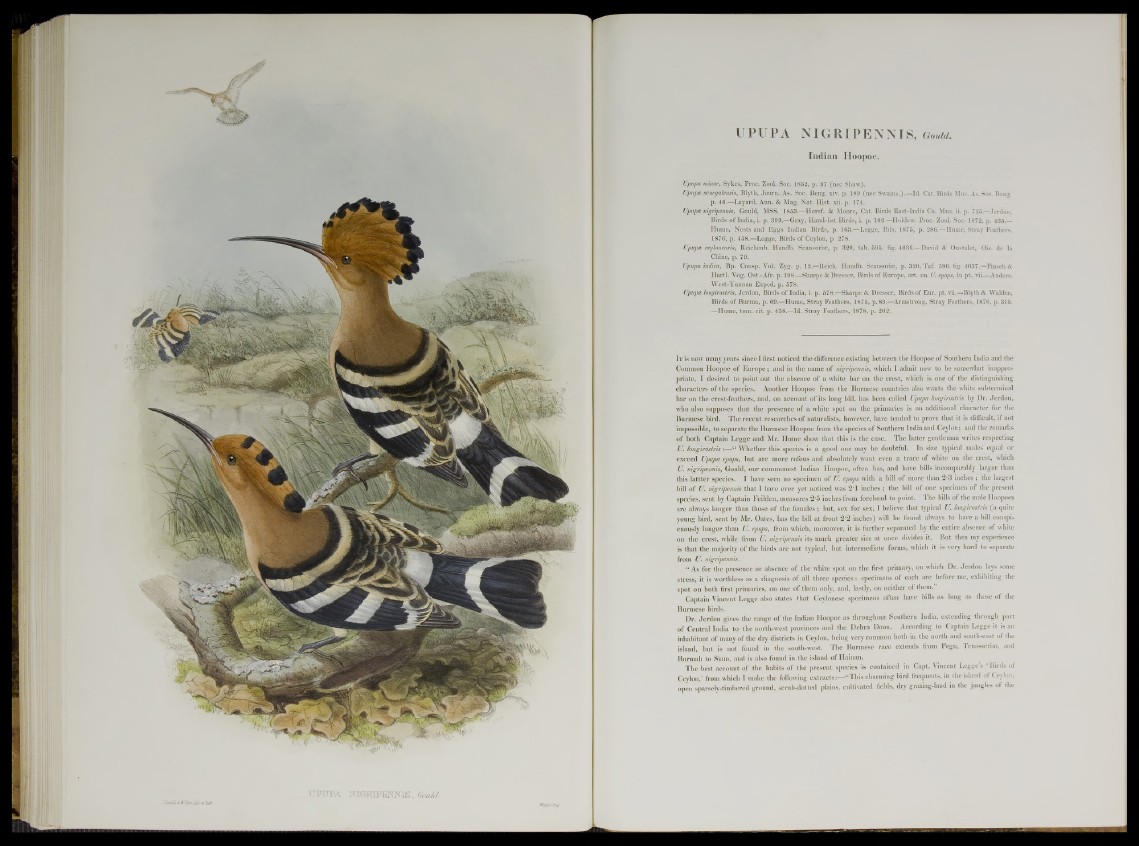
NIGRIPENNIS. G ou/d
UPUPA NIGRIPENNIS, g,M
In d ian Hoopoe.
Upupa minor, Sykes, Proe. Zool. Soe. 1832, p. 97 (nec Shaw).
Upupa senegalensis, Blyth, Journ. As. Soc. Beng. xiv. p. 189 (nec Swains.).—Id. Cat. Birds Mus. As. Soc. Beng.
p. 46.—Layard, Ann. & Mag. Nat. Hist. xii. p. 174.
Upupa nigripennis, Gould, MSS. 1853.—Horsf. & Moore, Cat. Birds East-India Co. Mus. ii. p. 725.—Jerdon,
Birds of India, i. p. 392.—Gray, Hand-list Birds, i. p. 102.—Holdsw. Proc. Zool. Soc. 1872, p. 435.—
Hume, Nests and Eggs Indian Birds, p. 163.—Legge, Ibis, 1875, p. 286.— Hume, Stray Feathers,
1876, p. 458.—Legge, Birds of Ceylon, p. 278.
Upupa ceylonensis, Reichenb. Handb. Scansoriae, p. 320, tab. 595. fig. 4036.—David & Oustalet, Ois. de la
Chine, p. 79.
Upupa indica, Bp. Consp. Vol. Zyg. p. 12.—Reich. Handb. Scansorise, p. 320, Taf. 596. fig. 4037.—Finsch &
Hartl. Yog. Ost.-Afr. p. 198.—Sharpe & Dresser, Birds of Europe, art. on U. epops, in p t. vii.—Anders.
West-Yunnan Exped. p. 578.
Upupa longirostris, Jerdon, Birds of India, i. p. 578.—Sharpe & Dresser, Birds of Eur. pt. vii.—Blyth & Walden,
Birds of Burma, p. 69.—Hume, Stray Feathers, 1875, p. 89.—Armstrong, Stray Feathers, 1876, p. 315.
—-Hume, tom. cit. p. 458.—Id. Stray Feathers, 1878, p. 202.
I t is now many years since I first noticed the difference existing between the Hoopoe of Southern India and the
Common Hoopoe of Europe; and in the name of nigripennis, which I admit now to be somewhat inappropriate,
I desired to point out the absence of a white bar on the crest, which is one of the distinguishing
characters of the species. Another Hoopoe from the Burmese countries also wants the white subterminal
bar on the crest-feathers, and, on account of its long bill, has been called Upupa longirostris by Dr. Jerdon,
who also supposes that the presence of a white spot on the primaries is an additional character for the
Burmese bird. The recent researches of naturalists, however, have tended to prove that it is difficult, if not
impossible, to separate the Burmese Hoopoe from the species of Southern India and Ceylon; and the remarks
of both Captain Legge and Mr. Hume show that this is the case. The latter gentleman writes respecting
U. longirostris:—“ Whether this species is a good one may be doubtful. In size typical males equal or
exceed Upupa epops, but are more rufous and absolutely want even a trace of white on the crest, which
U. nigripennis, Gould, our commonest Indian Hoopoe, often has, and have bills incomparably larger than
this lattter species. I have seen no specimen of U epops with a bill of more than 2 3 inches ; the largest
bill of U. nigripennis that I have ever yet noticed was 2'1 inches ; the bill of one specimen of the present
species, sent by Captain Feilden, measures 2‘5 inches from forehead to point. The bills of the male Hoopoes
are always longer than those of the females; but, sex for sex, I believe that typical U. longirostris (a quite
young bird, sent by Mr. Oates, has the bill at front 2*2 inches) will be found always to have a bill conspicuously
longer than U. epops, from which, moreover, it is further separated by the entire absence of white
on the crest, while from U. nigripennis its much greater size at once divides it. But then my experience
is that the majority of the birds are not typical, but intermediate forms, which it is very hard to separate
from U. nigripennis.
“ As for the presence or absence of the white spot on the first primary, on which Dr. Jerdon lays some
stress, it is worthless as a diagnosis of all three species: specimens of each are before me, exhibiting the
spot on both first primaries, on one of them only, and, lastly, on neither of them.
Captain Vincent Legge also states that Ceylonese specimens often have bills as long as those of the
Burmese birds.
Dr. Jerdon gives the range of the Indian Hoopoe as throughout Southern India, extending through part
of Central India to the north-west provinces and the Dehra Doon. According to Captain Legge it is an
inhabitant of many of the dry districts in Ceylon, being very common both in the north and south-east of the
island, but is not found in the south-west. The Burmese race extends from Pegu, Teuasserim, and
Burmah to Siam, and is also found in the island of Hainan.
The best account of the habits of the present species is contained in Capt. Vincent Legge’s ‘ Birds of
Ceylon,’ from which I make the following extracts:—“This charming bird frequents, in the island of Ceylon,
open sparsely-timbered ground, scrub-dotted plains, cultivated fields, dry grazing-land in the jungles of the